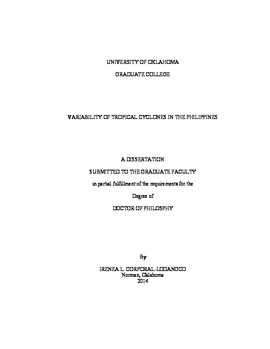| dc.description.abstract | The massive impacts of tropical cyclones (TCs) on the Philippines are well known. This study provides an improved understanding of TC activity in the country, allowing improved risk mitigation strategies that possibly can reduce the economic cost and fatalities from TCs. About 70% of tropical cyclones (TCs) in the western North Pacific (WNP) affect the Philippine region, with an annual median of 18 TCs for 1945-2011. The Philippine region has no TC free months, and here the calendar year is partitioned into the less active (LAS) and more active (MAS) seasons. A unique aspect that arose from this study is the nature of the transition periods between the LAS and the MAS. Philippine TC activity is defined by a comprehensive range of seasonal metrics, including: frequency, landfall, total days, earliest start/end dates, latest start/end dates, season lengths, genesis locations, and tracks.
The annual median for the LAS (MAS) frequency is 2 (15) with an interquartile range (IQR) 2 (4.5); the median LAS (MAS) landfalling frequency is 1 (5); and the median TC days is 8 (51). The median LAS (MAS) start and end dates are February 28th and May 20th (June 18th and December 16th). The median LAS (MAS) season length is 61 (176) days with IQR of 101 (28) days. The LAS (MAS) birthplaces are latitudinally bounded by 20°N (27°N) latitude and tracks by 46°N (55°N). A quiescent (TC free) period is identified between the LAS and MAS, varying from 2 days to 5 months (median 1.2 months) for LAS/MAS transition and 8 days to 5.6 months (median 2.85 months) for MAS/LAS transition.
Wavelet analysis reveals El Niño-Southern Oscillation (ENSO) as the dominant global mode affecting Philippine TC activity. The impacts of ENSO depend on the season, the ENSO phase, and on the intensity of the TCs. Significant change in the median seasonal metrics is observed as different ENSO phases influence the region.
In Neutral conditions, both seasons have above average number of TCs and landfalls. During La Niña (El Niño) phase, above (below) average TC numbers are observed in LAS while both La Niña and El Niño phases observed below average in MAS. The landfalling TCs are above (below) average in La Niña (El Niño) years in both LAS and MAS.
Relative to Neutral years, the mean start date of the LAS is earlier (later) in La Niña (El Niño) years while the mean end date is later (earlier) in La Niña (El Niño) years. The average length of LAS is longer in La Niña years as compared with Neutral years; El Niño conditions have even shorter season length. In MAS, the average start date during La Niña years is much later relative to Neutral and El Niño years. El Niño conditions have the earliest end date but La Niña conditions end date is earlier than that of Neutral conditions. The MAS length during La Niña phase is the shortest as compared with El Niño and Neutral phases.
In both LAS and MAS, the TC birthplaces are closer to the Philippines in La Niña years and are found in broader latitude range as opposed during El Niño years. Most of the TC tracks during La Niña (El Niño) phase occupy a broader (narrower) longitude range in LAS but La Niña (El Niño) conditions have a narrower (broader) longitude range in MAS.
A cluster analysis using k-means was employed to analyze the TCs in the Philippine region for the period 1945-2011. In this section, the clustering was implemented according to the TC genesis locations, decay locations, and tracks. The resultant silhouette coefficient values and key meteorological and oceanic variables have been examined to determine the optimal cluster number. The partitioning has revealed the following meaningful numbers of clusters: 4 for genesis locations, 5 for decay locations, and 6 for tracks.
The classification of TC genesis locations has captured the longitudinal separation of cyclogenesis regions. The formation region east of the Philippines (west of 140°E) is the most active, with 398 genesis points. TCs in the domain also exhibit distinct decay locations. The most prevalent area of dissipation is the cluster over Southeast Asia, with 352 decay points. Clustering the TC tracks has identified various track types by separating them into discrete numbers of patterns. Short, straight west-northwestward tracks heading towards Indochina have the highest density of trajectories, with 248 TCs.
To investigate the spatial and temporal behavior of Philippine TCs, monthly analyses of each cluster was carried out to show which cluster of genesis, decay, and tracks is most dominant during a specific month, which is a potentially useful forecast tool. The locations of TC formation determine the subsequent decay locations and TC paths. Once a TC is identified as belonging to one of the genesis clusters, the probable location of decay (including landfall location) along with the distinct trajectory type can be used as a forecasting guide. The monthly distribution of genesis, decay, and tracks also determines the variability in the seasonal cycles between clusters. | en_US |
